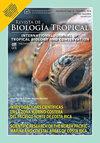巴西沿海Piauí州候鸟群落的时空格局和驱动因素
IF 0.6
4区 生物学
Q4 BIOLOGY
引用次数: 0
摘要
引言:迁徙是一种自然现象,包括许多鸟类每年对季节周期的反应。南美洲拥有大约三分之一的鸟类,是重要的鸟类种群,许多候鸟在巴西停留和越冬。目的:探讨候鸟与沿海植被的关系及环境对候鸟迁徙的影响。方法:2009年4月至2016年2月,在巴西Piauí州沿海10个点进行目测普查和雾网捕获。结果:共鉴定候鸟13目82种;大陆内迁徙种41种,北访种26种,游牧种14种,游民种1种。丰度高峰出现在旱季和雨季的开始和结束,与日照和大气压力相匹配。不同植被复合体间存在空间格局差异。黄皮蚊是植被指示蚊、湿地指示蚊、非淹地指示蚊、林草过渡指示蚊、果园指示蚊。尽管不同植被类型间物种数量和组成存在差异,但水源地、非水源地和过渡草地类型间物种丰富度的时间格局相似。结论:候鸟在Piauí州海岸停留期间占据了特定的环境,丰富度与日照和大气压力相匹配。本文章由计算机程序翻译,如有差异,请以英文原文为准。
Space-time patterns and drivers of migrant bird communities in coastal Piauí State, Brazil
Introduction: Migration is a natural phenomenon that includes annual movements of many bird species in response to seasonal cycles. With approximately one third of all living bird species, South America has an important avifauna, and many migrants land in Brazil at stopping points and wintering sites. Objective: To identify associations between migrant birds and coastal vegetation, and environmental influence of on migration. Methods: At 10 points along the coast of Piauí State, Brazil, we made visual censuses and mist net captures, between April 2009 and February 2016. Results: We identified 82 migrant bird species (13 orders; 28 families) that represented 41 intracontinental migrating species, 26 northern visiting species, 14 nomad species and one vagrant species. The richness peaks were at the beginning and end of both dry and rainy seasons, matching insolation and atmospheric pressure. There were spatial pattern differences among vegetation complexes. Chrysolampis mosquitus is an indicator of caatinga vegetation, Numenius phaeopus of wetland, Charadrius collaris of non-flooding fields, Rostrhamus sociabilis of forest-grassland transition, and Columbina picui of orchards. Despite differences in number and species composition within vegetation types, the temporal pattern in species richness was similar among flooded fields, non-flooded fields, and transition grassland categories. Conclusions: Migrant birds occupy specific environments during their permanence along the coast of Piauí State, with richness matching insolation and atmospheric pressure.
求助全文
通过发布文献求助,成功后即可免费获取论文全文。
去求助
来源期刊

Revista De Biologia Tropical
生物-生物学
CiteScore
1.80
自引率
0.00%
发文量
23
审稿时长
4-8 weeks
期刊介绍:
The Revista de Biología Tropical / International Journal of Tropical Biology and Conservation is a mainstream scientific journal published since 1953 and covered by Web of Science; Science Citation Index; Current Contents; Google Scholar; Scopus, SciELO and nearly 50 additional indices.
A double blind system guarantees you a fair evaluation, and our world class editorial and scientific boards provides a first decision in three working days. The journal is Full Open Access and is widely read where your article can have the highest real impact.
Since its beginning in 1953, the Revista follows these principles: objective and independent evaluation of all manuscripts; transparency in all processes; ethical use of procedures, data, specimens and subjects; fair treatment of all parties; and absolute predominance of scientific rigor over any other aspect.
 求助内容:
求助内容: 应助结果提醒方式:
应助结果提醒方式:


